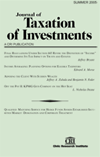Planning for the Kiddie Tax: Diversity With Investment Control
Author: Kermit O. Keeling.; Radie G. Bunn.; G. E. Whittenburg.
Source: Volume 21, Number 03, Spring 2004 , pp.272-287(16)

< previous article |next article > |return to table of contents
Abstract:
Because of the graduated tax rates in our Federal income tax system, affluent parents have been attempting to minimize the family tax liability by income shifting. This is accomplished by putting income-producing assets in a child’s name and have that income taxed at the child’s lower tax rate. The family benefits in two ways when income is properly shifted to family members in lower income tax brackets—not only is the overall income liability reduced; but the parents’ adjusted gross income (AGI) is also reduced. Assume, for example, that the parents’ marginal income tax bracket is 35%. If income can be shifted to a child or children whose lowest tax bracket is 10%, the family saves 25 cents on every dollar of income shifted. Additionally the parents AGI is reduced. Numerous income tax provision such as the child tax credit or educational credits are phased out as the parents’ AGI increases. Lowering AGI increases the parents’ eligibility for a number of these tax breaks.Keywords:
Affiliations:
1: Sellinger School of Business and Management, Loyola College, Maryland; 2: School of Accountancy, Southwest Missouri State University; 3: School of Accountancy, San Diego State University.